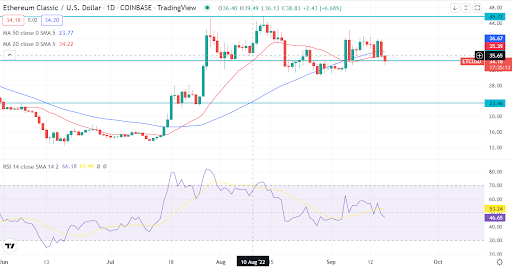
-
Ethereum Classic saw a 280% rise in hash rate after Ethereum Merge
-
The cryptocurrency surged after the Ethereum Merge but has since retraced
-
ETC lacks a directional bias as price slides
Ethereum finally completed a successful move from a Proof-of-Work blockchain to Proof-of-Stake. Immediately after the shift, tokens of PoW platforms such as Ethereum Classic ETC/USD rose. The cryptocurrency has since retreated with losses of 5.28% in the last 24 hours. Does that indicate a lack of sustainability in post-merge gains?
Ethereum Classic was one of the platforms expected to attract PoW miners after the Merge. On Thursday, immediately after the Merge, the hash rate on the protocol rose to 183 terahashes per second. That suggests a 280% increase in the crypto mining productivity in just 24 hours. It should, however, be noted that Ethereum Classic’s hashrate has increased by 500% in 30 days. Miners had already been positioning themselves for the post-merge situation. Hash rate on other PoW blockchains, such as Ergo blockchain and Ravencoin, has also surged.
There are possible scenarios to explain the depleted gains in ETC after the Ethereum Merge. First, ETC is trading close to a 5-month high, despite most tokens remaining subdued. Although we can’t discount further post-Merge gains, the price may have already factored in the developments.
A more profound factor preventing ETC’s post-Merge growth is the crypto sentiment. Across the board, cryptocurrencies are in the red following a more than-anticipated inflation. Consequently, ETC’s potential gains should be examined within the broader crypto sector.
ETC price movements and prediction post-Merge
 Source – TradingView
Source – TradingView
On the technical front, Ethereum Classic lacks a directional movement. The price has clashed below the moving averages but trades at a $34 support level. ETC must overcome a further drop below the support to consider a bullish bias.
Summary
Ethereum Classic has witnessed a rise in hash rate after Ethereum Merge. The price is yet to reflect the mining output and lacks a directional bias.

